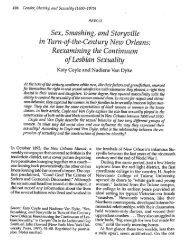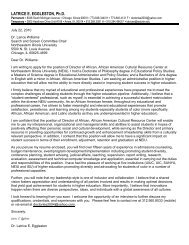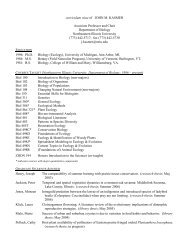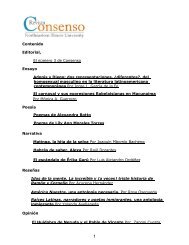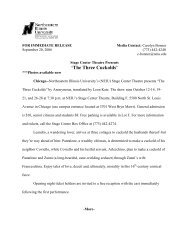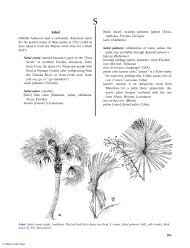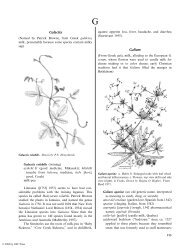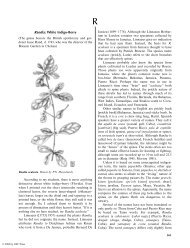Herba Cana - Northeastern Illinois University
Herba Cana - Northeastern Illinois University
Herba Cana - Northeastern Illinois University
Create successful ePaper yourself
Turn your PDF publications into a flip-book with our unique Google optimized e-Paper software.
© 2004 by CRC Press<br />
536 Florida Ethnobotany<br />
yerba de burro (donkey’s herb, Dominican Republic);<br />
yerba de caimán (caiman’s herb); yerba de<br />
hicotea [hycotea, jicotea] (turtle herb, the jicotea<br />
is a freshwater turtle, Taino, Dominican Republic,<br />
Puerto Rico)<br />
Most of Polygonum is referred to as ‘‘smartweed.’’<br />
Diggs et al. (1999) cite a comment by Kirkpatrick<br />
(1992) suggesting that the name was derived from the<br />
tendency of the sap to ‘‘smart’’ (burn) when it touched<br />
the skin. However, historical data support a slight<br />
modification of that view. ‘‘Smartweed’’ was applied<br />
to P. hydropiper by 1787. In that year, W.H. Marshall,<br />
writing on the rural economy of Norfolk, said,<br />
‘‘Smartweed, biting and pale-flowered persicarias;<br />
arsmart.’’ Indeed, the OED lists ‘‘arsesmart’’ as the<br />
common name for ‘‘smartweed.’’ So, Kirkpatrick had<br />
the right idea, but the wrong part of the body.<br />
Several species have a peppery taste, like P.<br />
hydropiperoides and its namesake P. hydropiper (water<br />
pepper). Indeed, Dutch herbalist Rembert Dodoens<br />
simply called the second species Hydropiper in 1554,<br />
surely reflecting its use in seasoning food. Fernald<br />
et al. (1958) noted that application for it and several<br />
relatives. The practice is problematical because some<br />
people develop contact dermatitis from the plants<br />
(Foster and Duke 1990).<br />
There appear to be no records of people in the<br />
Americas using P. densiflorum, but Hawaiians use an<br />
infusion of the plants to purify the blood (Moerman<br />
1998). Perhaps that species is used like some of the<br />
others in the New World although there are no records<br />
to support that. In the Bahamas, the root of P.<br />
densiflorum is crushed and inhaled to relieve headache<br />
(Higgs 1969).<br />
The earliest association of Polygonum with Florida<br />
people was P. hydropiperoides in pre-Columbian<br />
Glades coprolites from Fort Center on Lake Okeechobee<br />
(Hogan 1978). Polygonum hydropiperoides<br />
contains tannins, rutin (3% in the leaves), quercitin,<br />
and kaempferol (Hocking 1997). It has been used to<br />
stop intestinal and uterine hemorrhage, for strangury<br />
(slow, painful urination), and as a stimulant. In Brazil,<br />
P. hydropiperoides is considered diuretic, and an<br />
emmenagogue, and used as a treatment for piles. It is<br />
used to promote conception in Mexico (Ford 1975,<br />
Hocking 1997, Vásquez and Jácome 1997).<br />
Among the Houma, a decoction of P. punctatum<br />
roots was used to treat pains and swelling in the legs<br />
and joints (Speck 1941). Farther north, the Ojibwa<br />
took a decoction of leaves and flowers for stomach<br />
pain, and the Iroquois made a compound medicine for<br />
‘‘loss of senses during menses’’ (Moerman 1998). The<br />
Tarahumara of northwestern Mexico used the plants<br />
as a fish poison (Pennington 1958). They bundled the<br />
plants, crushed them, and put them in large baskets,<br />
which they dipped into water until the water turned<br />
green. According to Pennington (1958), ‘‘fish rise to<br />
the surface almost immediately.’’ Tarahumara also<br />
added young leaves to their corn dish esquiate for a<br />
spicy flavor.<br />
In Hispaniola, P. punctatum and other plants in<br />
the genus are rubefacients when crushed; they are<br />
stimulant, astringent, diuretic, emmenagogue, anthelmintic,<br />
and antiarthritic. On that island, the species is<br />
used against urinary and gallbladder problems, and to<br />
treat hemorrhoids, intermittent fever, and malignant<br />
sores (Liogier 1974). Several of the common names<br />
mention dogs. Those are indications that the herb is<br />
wild, but perhaps also indicates that the plant has been<br />
used to treat mange (jiote, fromxiotl, Náhuatl) in dogs<br />
(Morton 1981).<br />
Europeans were familiar with Polygonum when<br />
they arrived in the New World. They had learned that<br />
the small seeds from weedy species like P. aviculare<br />
could be harvested and used, at least as a starvation<br />
diet (Fernald et al. 1958). Indigenous Americans also<br />
used P. erectum in the same way. Indeed, there is<br />
evidence they cultivated that species for food (Smith<br />
1992). More recently, the seeds of at least P. hydropiperoides<br />
have been promoted as a protein source<br />
(Boyd 1968, Boyd and McGinty 1981).<br />
Polyporus<br />
(The genus was named by E.M. Fries, 1794 /1878, from<br />
Greek poly, many, and Latin porus, small openings)<br />
false truffle (USA)<br />
okipen (earth tuber, Virginia Algonquian)<br />
turma (truffle, name used by Fontaneda [1575]<br />
1944)<br />
When Hernando Descalante Fontaneda was rescued<br />
from his captivity among the Calusas of southern<br />
Florida, he returned to Spain and wrote an account of<br />
his time among those people (Fontaneda [1575] 1944).<br />
One of the few ‘‘plants’’ he mentioned was a root eaten<br />
by the Floridians. In speaking of people who lived on<br />
the laguna de mayaimi (Lake Okeechobee), he wrote,<br />
‘‘y sobre esta laguna que corre por en medio de la tierra<br />
dentro tiene muchos pueblos aunque son de treynta i<br />
quarenta vso. y otros tantos lugares tienen pan de rraises<br />
ques la comida ordinaria la mar parte del tienpo, aunque<br />
por caso de la laguna que crese mucho que no alcansan<br />
estas rraises por estorbo de la mucha Agua y ansi dejan<br />
de comer Algun tienpo este pan pescado mucho y muy<br />
bueno, otras Rayses a manera de turmas de las de Aca<br />
duses.’’





